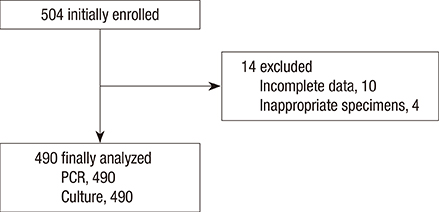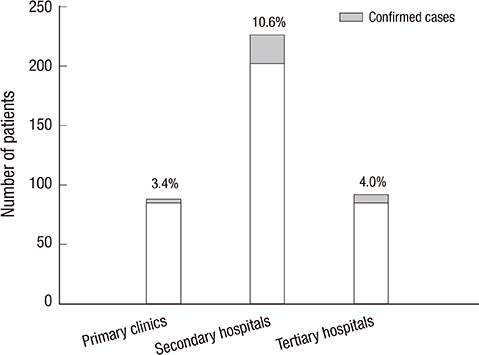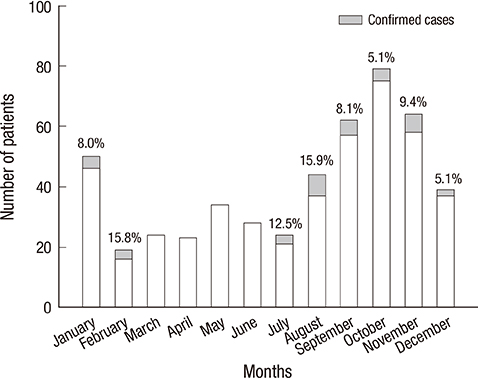J Korean Med Sci.
2014 Sep;29(9):1232-1239. 10.3346/jkms.2014.29.9.1232.
Epidemiological Aspects of Pertussis among Adults and Adolescents in a Korean Outpatient Setting: A Multicenter, PCR-Based Study
- Affiliations
-
- 1Division of Pulmonary, Allergy and Critical Care Medicine, Hallym University Sacred Heart Hospital, Anyang, Korea. pulmoks@hallym.ac.kr
- 2Seegene Medical Foundation, Seoul, Korea.
- 3Division of Pulmonary and Critical Care Medicine, Soonchunhyang University Hospital, Cheonan, Korea.
- 4Division of Pulmonary, Allergy and Critical Care Medicine, Yeungnam University Medical Center, Daegu, Korea.
- 5Division of Pulmonary, Allergy and Critical Care Medicine, Kangdong Sacred Heart Hospital, Seoul, Korea.
- 6Division of Pulmonary, Allergy and Critical Care Medicine, Chuncheon Sacred Heart Hospital, Chuncheon, Korea.
- 7Division of Pulmonary, Allergy and Critical Care Medicine, Konkuk University Hospital, Seoul, Korea.
- 8Division of Pulmonary, Allergy and Critical Care Medicine, Wonkwnag University Sanbon Hospital, Gunpo, Korea.
- 9Division of Pulmonary, Allergy and Critical Care Medicine, Dankook University Hospital, Cheonan, Korea.
- 10Division of Pulmonary, Allergy and Critical Care Medicine, Inha University Hospital, Incheon, Korea.
- 11Division of Pulmonary Medicine, Gwangju Christian Hospital, Gwangju, Korea.
- 12Department of Allergy, Dong-A University Hospital, Busan, Korea.
- 13Onnuri Clinic of Internal Medicine, Jeonju, Korea.
- 14Rapha Clinic of Otolaryngology, Anyang, Korea.
- 15Cheongchun Clinic of Internal Medicine, Daegu, Korea.
- 16Leejaemyeong Clinic of Internal Medicine, Anyang, Korea.
- 17Hanaro Clinic of Internal Medicine, Daejeon, Korea.
- 18Hallym Clinic of Internal Medicine, Hongcheon, Korea.
- KMID: 1794601
- DOI: http://doi.org/10.3346/jkms.2014.29.9.1232
Abstract
- Epidemiological data of Bordetella pertussis infection among adolescents and adults are limited in Korea. Patients (> or = 11 yr of age) with a bothersome cough for less than 30 days were enrolled during a 1-yr period at 22 hospitals in Korea. Nasopharyngeal swabs were collected for polymerase chain reaction (PCR) and for bacteriologic culture. In total, 490 patients were finally enrolled, and 34 (6.9%) patients tested positive for B. pertussis; cough duration (14.0 days [7.0-21.0 days]) and age distribution were diverse. The incidence was the highest in secondary referral hospitals, compared to primary care clinics or tertiary referral hospitals (24/226 [10.6%] vs. 3/88 [3.4%] vs. 7/176 [4.0%], P = 0.012), and the peak incidence was observed in February and August (15.8% and 15.9%), with no confirmed cases between March and June. In the multivariate analysis, post-tussive vomiting was significantly associated with pertussis (odds ratio, 2.508; 95% confidence interval, 1.146-5.486) and secondary referral hospital showed a borderline significance. In conclusion, using a PCR-based method, 6.9% of adolescent and adult patients with an acute cough illness had pertussis infection in an outpatient setting. However, hospital levels and seasonal trends must be taken into account to develop a better strategy for controlling pertussis.
MeSH Terms
-
Adolescent
Adult
Bordetella pertussis/*genetics
Child
DNA, Bacterial/*analysis
Demography
Female
Humans
Incidence
Male
Middle Aged
Multivariate Analysis
Odds Ratio
*Polymerase Chain Reaction
Republic of Korea/epidemiology
Seasons
Vomiting/etiology
Whooping Cough/*epidemiology/microbiology/pathology
Young Adult
DNA, Bacterial
Figure
Cited by 1 articles
-
Clinical Characteristics of Pertussis Epidemic in Changwon
Joon Weon Jang, Jin Han Kang, Jae Won Choi, Hak Sung Lee, Sang Hyuk Ma
Pediatr Infect Vaccine. 2017;24(1):37-43. doi: 10.14776/piv.2017.24.1.37.
Reference
-
1. Hewlett EL, Edwards KM. Clinical practice: pertussis - not just for kids. N Engl J Med. 2005; 352:1215–1222.2. Stojanov S, Liese J, Belohradsky BH. Hospitalization and complications in children under 2 years of age with Bordetella pertussis infection. Infection. 2000; 28:106–110.3. Celentano LP, Massari M, Paramatti D, Salmaso S, Tozzi AE. EUVAC-NET Group. Resurgence of pertussis in Europe. Pediatr Infect Dis J. 2005; 24:761–765.4. Mooi FR, Van Der Maas NA, De Melker HE. Pertussis resurgence: waning immunity and pathogen adaptation - two sides of the same coin. Epidemiol Infect. 2014; 142:685–694.5. Cherry JD. Epidemic pertussis in 2012: the resurgence of a vaccine-preventable disease. N Engl J Med. 2012; 367:785–787.6. Kwon HJ, Yum SK, Choi UY, Lee SY, Kim JH, Kang JH. Infant pertussis and household transmission in Korea. J Korean Med Sci. 2012; 27:1547–1551.7. Cherry JD. The epidemiology of pertussis: a comparison of the epidemiology of the disease pertussis with the epidemiology of Bordetella pertussis infection. Pediatrics. 2005; 115:1422–1427.8. Cherry JD. Epidemiology of pertussis. Pediatr Infect Dis J. 2006; 25:361–362.9. Jackson LA, Cherry JD, Wang SP, Grayston JT. Frequency of serological evidence of Bordetella infections and mixed infections with other respiratory pathogens in university students with cough illnesses. Clin Infect Dis. 2000; 31:3–6.10. Park S, Lee MG, Lee KH, Park YB, Yoo KH, Park JW, Kim C, Lee YC, Park JS, Kwon YS, et al. A Multicenter Study of Pertussis Infection in Adults with Coughing in Korea: PCR-Based Study. Tuberc Respir Dis (Seoul). 2012; 73:266–272.11. Park WB, Park SW, Kim HB, Kim EC, Oh M, Choe KW. Pertussis in adults with persistent cough in South Korea. Eur J Clin Microbiol Infect Dis. 2005; 24:156–158.12. Broder KR, Cortese MM, Iskander JK, Kretsinger K, Slade BA, Brown KH, Mijalski CM, Tiwari T, Weston EJ, Cohn AC, et al. Preventing tetanus, diphtheria, and pertussis among adolescents: use of tetanus toxoid, reduced diphtheria toxoid and acellular pertussis vaccines recommendations of the Advisory Committee on Immunization Practices (ACIP). MMWR Recomm Rep. 2006; 55:1–34.13. Regan J, Lowe F. Enrichment medium for the isolation of Bordetella. J Clin Microbiol. 1977; 6:303–309.14. Lautrop H. Laboratory diagnosis of whooping-cough or Bordetella infections. Bull World Health Organ. 1960; 23:15–35.15. Glare EM, Paton JC, Premier RR, Lawrence AJ, Nisbet IT. Analysis of a repetitive DNA sequence from Bordetella pertussis and its application to the diagnosis of pertussis using the polymerase chain reaction. J Clin Microbiol. 1990; 28:1982–1987.16. Houard S, Hackel C, Herzog A, Bollen A. Specific identification of Bordetella pertussis by the polymerase chain reaction. Res Microbiol. 1989; 140:477–487.17. Cherry JD. The science and fiction of the "resurgence" of pertussis. Pediatrics. 2003; 112:405–406.18. Korean Centers for Disease Control and Prevention. Sentinal surveillance systems for communicable infectious diseases. accessed 30 December 2012. Available at http://www.cdc.go.kr.19. Birkebaek NH, Kristiansen M, Seefeldt T, Degn J, Moller A, Heron I, Andersen PL, Moller JK, Ostergård L. Bordetella pertussis and chronic cough in adults. Clin Infect Dis. 1999; 29:1239–1242.20. Cattaneo LA, Reed GW, Haase DH, Wills MJ, Edwards KM. The seroepidemiology of Bordetella pertussis infections: a study of persons ages 1-65 years. J Infect Dis. 1996; 173:1256–1259.21. Miller E, Fleming DM, Ashworth LA, Mabbett DA, Vurdien JE, Elliott TS. Serological evidence of pertussis in patients presenting with cough in general practice in Birmingham. Commun Dis Public Health. 2000; 3:132–134.22. Loeffelholz MJ, Thompson CJ, Long KS, Gilchrist MJ. Comparison of PCR, culture, and direct fluorescent-antibody testing for detection of Bordetella pertussis. J Clin Microbiol. 1999; 37:2872–2876.23. Zouari A, Smaoui H, Kechrid A. The diagnosis of pertussis: which method to choose? Crit Rev Microbiol. 2012; 38:111–121.24. Von König CH, Halperin S, Riffelmann M, Guiso N. Pertussis of adults and infants. Lancet Infect Dis. 2002; 2:744–750.25. Lieberman D, Shvartzman P, Lieberman D, Ben-Yaakov M, Lazarovich Z, Hoffman S, Mosckovitz R, Ohana B, Leinonen M, Luffy D, et al. Etiology of respiratory tract infection in adults in a general practice setting. Eur J Clin Microbiol Infect Dis. 1998; 17:685–689.26. Centers for Disease Control and Prevention. Epidemiology and Prevention of Vaccine-Preventable Diseases. 12th ed. Atlanta: Pinkbook;2012.27. De Greeff SC, Dekkers AL, Teunis P, Rahamat-Langendoen JC, Mooi FR, De Melker HE. Seasonal patterns in time series of pertussis. Epidemiol Infect. 2009; 137:1388–1395.28. Rendi-Wagner P, Paulke-Korinek M, Stanek G, Khanakah G, Kollaritsch H. Impact of a pertussis booster vaccination program in adolescents and adults on the epidemiology of pertussis in Austria. Pediatr Infect Dis J. 2007; 26:806–810.29. Weston WM, Friedland LR, Wu X, Howe B. Vaccination of adults 65 years of age and older with tetanus toxoid, reduced diphtheria toxoid and acellular pertussis vaccine (Boostrix®): results of two randomized trials. Vaccine. 2012; 30:1721–1728.30. Strebel P, Nordin J, Edwards K, Hunt J, Besser J, Burns S, Amundson G, Baughman A, Wattigney W. Population-based incidence of pertussis among adolescents and adults, Minnesota, 1995-1996. J Infect Dis. 2001; 183:1353–1359.31. Yaari E, Yafe-Zimerman Y, Schwartz SB, Slater PE, Shvartzman P, Andoren N, Branski D, Kerem E. Clinical manifestations of Bordetella pertussis infection in immunized children and young adults. Chest. 1999; 115:1254–1258.32. Miyashita N, Akaike H, Teranishi H, Kawai Y, Ouchi K, Kato T, Hayashi T, Okimoto N. Diagnostic value of symptoms and laboratory data for pertussis in adolescent and adult patients. BMC Infect Dis. 2013; 13:129.
- Full Text Links
- Actions
-
Cited
- CITED
-
- Close
- Share
- Similar articles
-
- Pertussis Prevalence in Korean Adolescents and Adults with Persistent Cough
- Pertussis as a Differential Diagnosis of Chronic Cough in Adults
- Three Cases of Pertussis in Infants younger than Three Months without Immunization of DTaP
- Infection Control and Re-emergence of Pertussis in South Korea
- Pertussis Seroprevalence in Korean Adolescents and Adults Using Anti-Pertussis Toxin Immunoglobulin G







